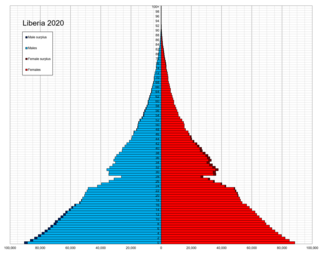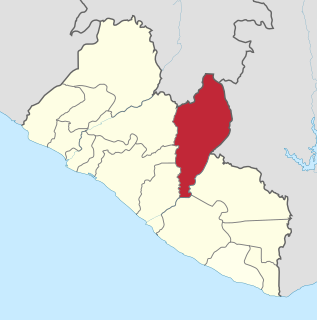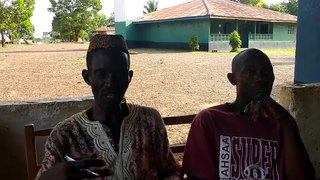Bamana, also known as Bambara or Bamanankan is a lingua franca and national language of Mali spoken by perhaps 15 million people, natively by 5 million Bambara people and about 10 million second-language users. It is estimated that about 80 percent of the population of Mali speak Bambara as a first or second language. It has a subject–object–verb clause structure and two lexical tones. The native name bamanankan means "the language of heathens, people who refuse Islam", as opposed to speakers of Dyula, who are Muslim.

As of 2006, Liberia has the highest population growth rate in the world. 43.5% of Liberians were below the age of 15 in 2010. With recent civil wars being fought along ethnic lines, Liberia is a multiethnic and multicultural country.

The culture of Liberia reflects this nation's diverse ethnicities and long history. Liberia is located in West Africa on the Atlantic Coast.

The Bassa people are a West African ethnic group primarily native to Liberia. They form a majority or a significant minority in Liberia's Grand Bassa, Rivercess, Margibi and Montserrado counties. In Liberia's capital of Monrovia, they are the largest ethnic group. With an overall population of about 0.57 million, they are the second largest ethnic group in Liberia (13.4%), after the Kpelle people (20.3%). Small Bassa communities are also found in Sierra Leone and Ivory Coast.

Guinée forestière is a forested mountainous region in southeastern Guinea, extending into northeastern Sierra Leone. It is one of four natural regions into which Guinea is divided and covers 23% of the country. It includes all of the Nzérékoré administrative region, and shares a border with Sierra Leone and Liberia. Its rocky topology contains several mountain ranges and has an average elevation of 460m. Forested Guinea contains important areas of biological diversity such as the UNESCO World Heritage site Mount Nimba Strict Nature Reserve and biosphere reserve Ziama Massif. The Guéckédou prefectures also recorded the initial case of the 2014 Ebola outbreak in Meliandou, a rural village. The virus subsequently spread to urban areas and neighbouring countries Sierra Leone and Liberia.

Nimba County is a county in northeastern Liberia that shares borders with the Republic of Côte d'Ivoire in the East and the Republic of Guinea in the Northwest. Its capital city is Sanniquellie and its most populous city is Ganta. With the county's area measuring 11,551 square kilometres (4,460 sq mi), Nimba is the largest of Liberia's 15 counties. The county has six statutory districts. As of the 2008 Census, it had a population of 462,026, making it the second most-populous county in Liberia.
Mende is a major language of Sierra Leone, with some speakers in neighboring Liberia. It is spoken by the Mende people and by other ethnic groups as a regional lingua franca in southern Sierra Leone.

The Vai are a Manden ethnic group that live mostly in Liberia, with a small minority living in south-eastern Sierra Leone. The Vai are known for their indigenous syllabic writing system known as Vai syllabary, developed in the 1820s by Momolu Duwalu Bukele and other Vai elders. Over the course of the 19th century, literacy in the writing system became widespread. Its use declined over the 20th century, but modern computer technology may enable a revival.

The Vai language, also called Vy or Gallinas, is a Mande language spoken by the Vai people, roughly 104,000 in Liberia, and by smaller populations, some 15,500, in Sierra Leone.
Momolu Duwalu Bukele was the inventor of the Vai syllabary used for writing the Vai language of Liberia—one of several African languages to develop its own writing system.

The Kpelle people are the largest ethnic group in Liberia. They are located primarily in an area of central Liberia extending into Guinea. They speak the Kpelle language, which belongs to the Mande language family.

The Kpelle language is spoken by the Kpelle people and is part of the Mande family of languages. Guinean Kpelle, spoken by half a million people, concentrated primarily, but not exclusively, in the forest regions of Guinea, whose capital, Nzérékoré, is the third largest city in Guinea and the largest city in the Guinée forestière region of south-eastern Guinea bordering Liberia, Ivory Coast, and Sierra Leone. Liberian Kpelle, spoken by half again as many, is currently taught in schools in Liberia.

The Vai syllabary is a syllabic writing system devised for the Vai language by Momolu Duwalu Bukele of Jondu, in what is now Grand Cape Mount County, Liberia. Bukele is regarded within the Vai community, as well as by most scholars, as the syllabary's inventor and chief promoter when it was first documented in the 1830s. It is one of the two most successful indigenous scripts in West Africa in terms of the number of current users and the availability of literature written in the script, the other being N'Ko.

The Loma people, sometimes called Loghoma, Looma, Lorma or Toma, are a West African ethnic group living primarily in the northern mountainous, sparsely populated regions of Guinea and Liberia. Their population was estimated at 330,000 in the two countries in 2010. They are closely related to the Mende people.

The writing systems of Africa refer to the current and historical practice of writing systems on the African continent, both indigenous and those introduced.
Liberian Americans are an ethnic group of Americans of full or partial Liberian ancestry. This includes Liberians who are of American descent. It also includes the descendants of Americo-Liberian people in America. The first wave of Liberians to the United States, after the slavery period, was after of the First Liberian Civil War in the 1980s and, then, after the Second Liberian Civil War in the early 2000s. An estimated 100,000 Liberians live in the U.S. as of this time. The diplomatic relationship between Liberia and the USA goes back over 150 years since Liberia's foundation by returning African slaves freed by abolitionist societies which set aside land for the freedmen and paved the way to its independence.

Loma is a Mande language spoken by the Loma people of Liberia and Guinea.
The Southwestern Mande languages are a branch of the Mande languages spoken in Sierra Leone, Guinea, and Liberia. There are around 2.8 million speakers, chiefly in Sierra Leone, due to Mende, the language with the most overall speakers. The Southwestern Mande languages are distantly related to the historic Manding languages.













